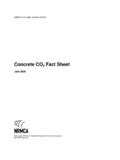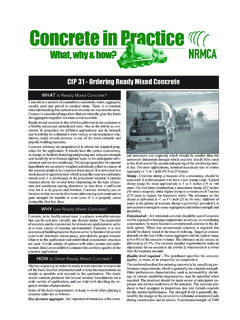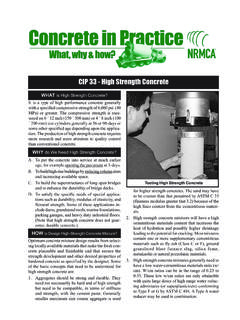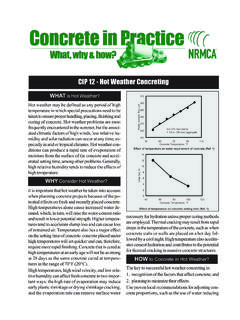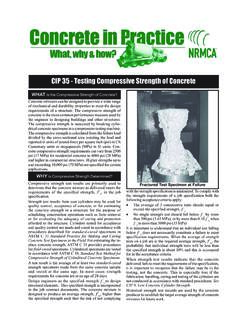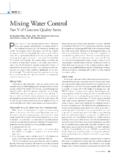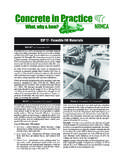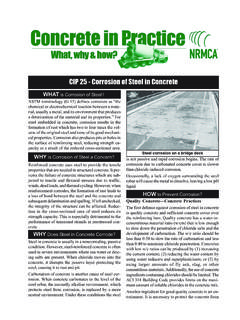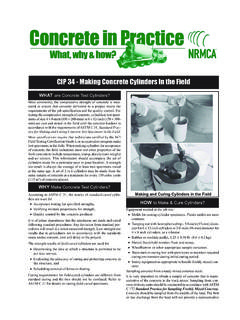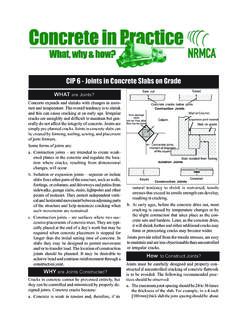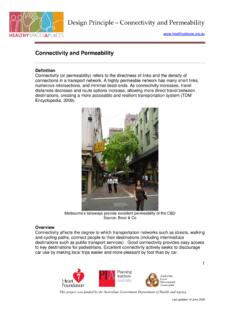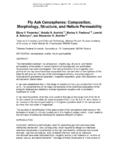Transcription of CIP 24 - Synthetic Fibers for Concrete
1 CIP 24 - Synthetic Fibers for ConcreteWHAT are Synthetic Fibers ? Synthetic Fibers specifically engineered for concreteare manufactured from man-made materials that canwithstand the long-term alkaline environment ofconcrete. Synthetic Fibers are added to Concrete be-fore or during the mixing operation. The use of syn-thetic Fibers at typical addition rates does not requireany mix design Synthetic Fibers ?HOWdo Synthetic Fibers Work inEarly Age Concrete ?HOWdo Synthetic Fibers Work inHardened Concrete ? Synthetic Fibers benefit the Concrete in both the plas-tic and hardened state. Some of the benefits include: reduced plastic settlement cracks reduced plastic shrinkage cracks lowered permeability increased impact and abrasion resistance providing shatter resistanceSome Synthetic Fibers may be used as secondary re-inforcement.
2 (Hardened Concrete Performance Docu-mentation Required.)Early age volume changes in Concrete cause weak-ened planes and cracks to form because a stress ex-ists which exceeds the strength of the Concrete at aspecific time. The growth of these micro shrinkagecracks is inhibited by mechanical blocking action ofthe Synthetic Fibers . The internal support system ofthe Synthetic Fibers inhibits the formation of plastic settle-ment cracks. The uniform distribution of fibersthroughout the Concrete discourages the developmentof large capillaries caused by bleed water migrationto the surface. Synthetic Fibers lower permeabilitythrough the combination of plastic crack reduction andreduced bleeding early age Concrete benefits of using Synthetic fi-bers continue to contribute to the hardened Concrete attributes provided by syntheticfibers are lowered permeability and the resistance toshattering, abrasion, and impact ability to resist shattering forces is greatly enhancedwith the introduction of Synthetic Fibers to the con-crete.
3 When plain Concrete is compressed, it will shat-ter and fail at first crack. Synthetic Fibers manufac-tured specifically for Concrete prevent the effect ofshattering forces by tightly holding the Concrete resistance is provided when Synthetic fibersare used because the water-cement ratio at the sur-face is not lowered by variable bleed water. The wa-ter-cement ratio is more constant at the Concrete sur-face. This improvement is assisted by the internalsettlement support value of the Synthetic Fibers con-One type of Synthetic Fibers used in concrete1994 Synthetic Fibers which meet certain hardened concretecriteria can be used as nonstructural temperature orsecondary reinforcement. These Fibers should havedocumentation confirming their ability to hold concretetogether after uniform distribution of Synthetic Fibers throughoutthe Concrete ensures the critical positioning of sec-ondary to uniform Fibers reduce the amount of plastic crackingof the Concrete .
4 This improves the impact resistanceof Concrete . The relatively low modulus of the syn-thetic Fibers provides shock absorption Fibers help the Concrete develop its opti-mum long-term integrity by the reduction of plasticsettlement and shrinkage crack formation, loweredpermeability, and increased resistance to abrading,shattering, and impact forces. Synthetic Fibers are com-patible with all admixtures, silica fumes, and are Synthetic Fibers Used as Sec-ondary Reinforcement?References1. ASTM C 1116 Standard Specification Fiber ReinforcedConcrete and ASTM C 1018 Standard Test Method for Flexural Tough-ness and First-Crack Strength of Fiber Reinforced Con-crete (Using Beam with Third-Point Loading).
5 3. ASTM C 78 Test Method for Flexural Strength of Con-crete (Using Simple Beam with Third-Point Loading).4. Non-structural Cracks in Concrete , Concrete SocietyTechnical Report No. ICBO Evaluation Service, Inc., Acceptance Criteria forConcrete with Synthetic Fibers , January GUIDELINESDo Use Synthetic Fibers For: The reduction of Concrete cracking as a result of plastic shrinkage. An alternate system of nonstructural secondary and/or temperature reinforcement. Greater impact, abrasion, and shatter resistance in Concrete . Internal support and cohesiveness; the Concrete for steep inclines, shotcrete, and slipformed placements. The reduction of Concrete cracking as a result of plastic settlement.
6 To help lower the permeability of Concrete . Placements where nonmetallic materials are required. Areas requiring materials that are both alkali proof and chemical Use Synthetic Fibers For: The control of cracking as a result of external forces. Higher structural strength development. Replacement of any moment-resisting or structural steel reinforcement. Decreasing the thickness of slabs on grade. The elimination or reduction of curling and/or creep. Increasing of ACI or PCA control joint guidelines. The justification for a reduction in the size of the support columns. The thinning out of bonded or unbonded overlay sections.
